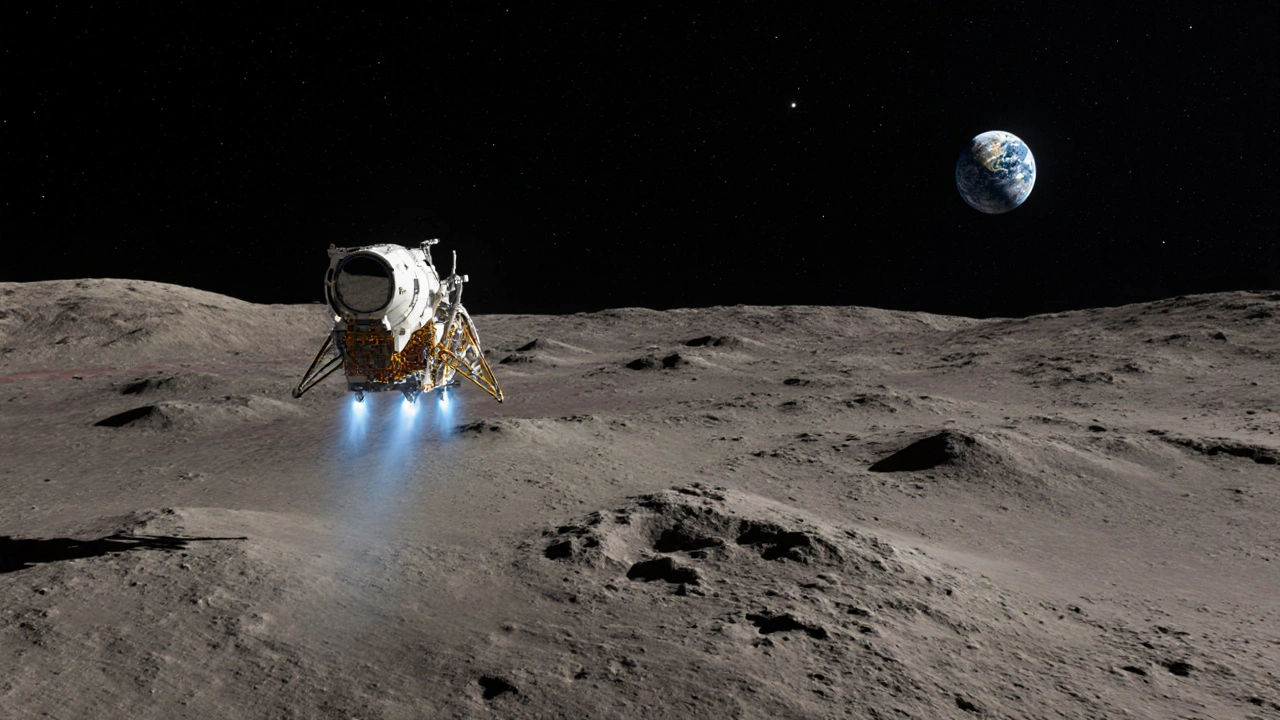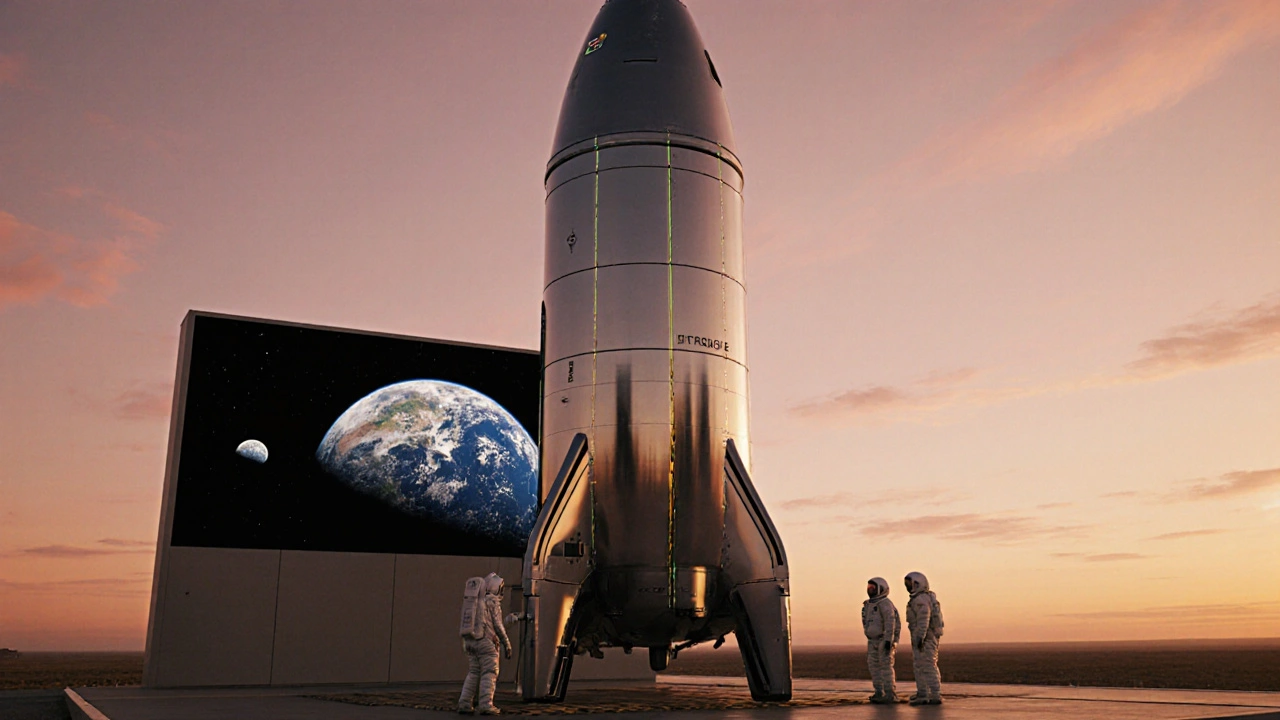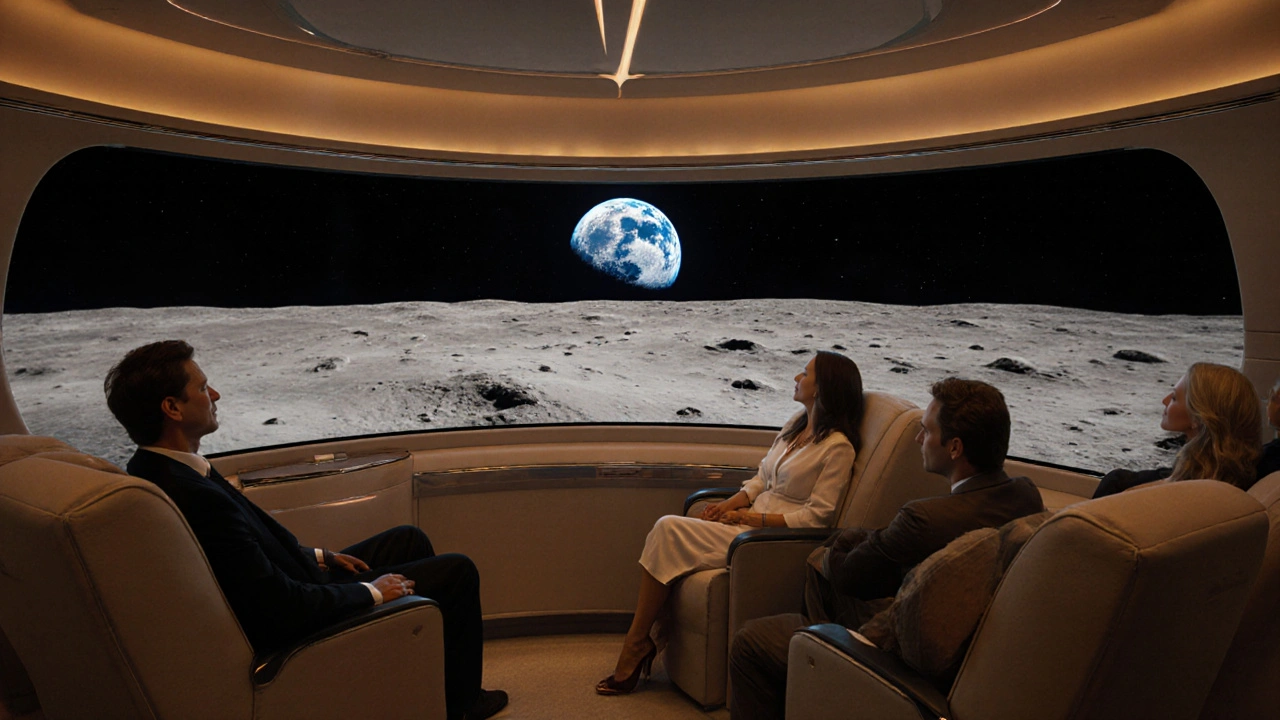Key Takeaways
- Private lunar tourism currently means a circumlunar flyby, not a surface landing.
- Space Adventures has been quoting $150 million per seat for a 8‑day flyby since the early 2010s.
- SpaceX’s Starship could drop prices dramatically, but human‑rating won’t be ready before the early 2030s.
- Radiation exposure, intensive training, and geopolitical risk are the biggest barriers today.
- Analysts predict 5‑10 annual customers by 2035 if Starship becomes operational, rising to 25‑50 by 2040.
Lunar tourism is a niche segment of the broader space‑tourism market that sells private trips around the Moon without a surface landing. The idea grew out of orbital tourism successes like Dennis Tito’s 2001 ISS flight, and it promises an ultra‑exclusive view of the far side of the Moon and the iconic Earthrise. As of October 2025 no private circumlunar mission has launched, but several companies are racing to turn the dream into a ticketed experience.
How a Circumlunar Trip Works
A circumlunar, or “circumlunar,” flight follows a translunar injection (TLI) that sends a spacecraft on a free‑return trajectory around the Moon. The craft usually flies past the lunar surface at about 100 km altitude, lingers for roughly 24 hours, then uses Moon‑gravity to sling back toward Earth. The whole mission lasts 8‑9 days, offering passengers a full day of continuous lunar proximity.
Key technical steps include:
- Launch and TLI: A heavy‑lift rocket (Soyuz for Space Adventures, Starship for SpaceX) places the spacecraft into a low‑Earth orbit before a high‑energy burn sends it toward the Moon.
- Deep‑space cruise: The vehicle coasts for about three days, during which crew perform health checks and enjoy weightless observations.
- Lunar flyby: At closest approach passengers see the Moon’s far side, the terminator line, and the Earthrise silhouette.
- Return burn: A retro‑burn or the Moon’s gravity redirects the craft toward Earth, followed by re‑entry and splashdown.
Training mirrors ISS tourism: six months at Russia’s Gagarin Cosmonaut Training Center (aka Star City) covering centrifuge runs, parabolic flights, emergency procedures, and basic spacecraft systems. Medical standards are similar to those for low‑Earth‑orbit flights-candidates must pass a Category 1 health exam and demonstrate resilience to isolation.
Current Players and Their Proposals
Four companies dominate the conversation, each with a different approach and timeline.
| Company | Vehicle | Pricing (USD) | Status | First Flight Window |
|---|---|---|---|---|
| Space Adventures | Modified Soyuz TMA | $150 million per seat | Concept; awaiting launch provider | 2028 (optimistic) |
| SpaceX | Starship (fully reusable) | Projected $50‑75 million | In development; human‑rating years away | Early 2030s |
| Blue Origin | New Glenn (sub‑orbital focus) | Not disclosed for lunar | Sub‑orbital only; no lunar plans announced | N/A |
| Axiom Space | ISS‑based orbital module | $55‑70 million (orbital trips) | Orbital tourism only; lunar not planned | N/A |
| ispace | Hakuto‑R lander & OTV concept | Not public for tourism | Focus on sample‑return; exploring tourist transfer | Mid‑2030s (speculative) |
Space Adventures leverages a proven Soyuz platform, which gives it credibility but also ties it to Russian launch infrastructure-a growing geopolitical risk after 2022. SpaceX’s Starship promises a 100‑fold cost reduction thanks to full reuse, yet the vehicle still needs a human‑rating certification that NASA expects to complete no earlier than 2029. Blue Origin and Axiom continue to focus on sub‑orbital or low‑Earth‑orbit experiences, leaving the lunar niche to the two heavy‑lift contenders.

Cost, Market Size, and Expert Outlook
Pricing remains the most discussed metric. Space Adventures has stuck with a $150 million price tag for over a decade, representing a 425‑650 % premium over its earlier ISS seats that cost $20‑35 million. Analysts argue that this figure is unsustainable unless the market expands beyond a handful of ultra‑wealthy patrons.
Dr. John Logsdon (George Washington University) warned in 2024 that "circumlunar tourism remains a niche market for the ultra‑wealthy with questionable economic sustainability." By contrast, Dr. Julie Kwan (Space Tourism Society) projected in 2025 that “if Starship reaches operational status, we could see 5‑10 customers per year by 2035, climbing to 25‑50 annually by 2040 as prices drop to $50‑75 million.”
Market‑size forecasts vary widely:
- GetTransfer.com (2025‑2030) sees a $1.2 billion lunar‑tourism market by 2035.
- UBS (July 2025) predicts 500 annual lunar tourists by 2040 if costs fall below $100 million.
- Morgan Stanley (Sept 2025) caps the market at 25‑50 annual customers through 2045, citing persistent technical and regulatory barriers.
Even at the high‑end, lunar tourism would still represent under 5 % of the overall $28 billion space‑tourism market projected for 2035.
Risks and Practical Barriers
The biggest health concern is radiation. A Reddit‑engineered calculation by user u/OrbitalAnalyst (2025) estimated a circumlunar mission would expose passengers to 300‑400 mSv, roughly the dose of 15,000 chest X‑rays. That level exceeds the limits for most commercial‑flight crews and requires robust shielding or medical monitoring.
Geopolitics also loom large. Space Adventures’ reliance on Soyuz ties its timeline to Russian launch availability, which has been unpredictable since the 2022 invasion of Ukraine. Meanwhile, the United States is tightening export controls on dual‑use space technology, potentially limiting cross‑border collaborations.
Regulatory clarity is thin. The 1967 Outer Space Treaty governs activities but offers no specific licensing regime for private lunar flybys. The U.S. Commercial Space Launch Competitiveness Act of 2015 gives owners rights over extracted resources, but it does not address tourism liability, leaving companies to negotiate case‑by‑case with national space agencies.

Roadmap: When Might You Fly?
Most experts agree the first private circumlunar flight will not happen before 2030. Here’s a rough timeline based on current development paths:
- 2025‑2027: Final design reviews for Space Adventures’ DSE‑Alpha; Starship continues orbital test flights.
- 2028‑2030: Possible inaugural Soyuz‑based flyby if a launch slot is secured; SpaceX begins human‑rating milestones for Starship.
- 2031‑2034: Starship certified for crewed flight; commercial lunar flyby tickets open for early‑bird reservations.
- 2035‑2040: Market scales to double‑digit annual customers; second‑generation vehicles (e.g., ispace OTV) add dedicated Lunar‑Transfer Services.
Parallel infrastructure-lunar orbiting stations, refueling depots, and surface habitats-planned under NASA’s Artemis program will lower costs over the longer term, making a true surface‑tourism experience possible after 2040.
Checklist for Aspiring Lunar Tourists
- Secure a minimum net‑worth of $150 million (or the lower projected price if Starship becomes the provider).
- Pass a Category 1 medical exam and obtain a radiation‑exposure clearance.
- Complete at least six months of intensive training at a recognized astronaut center (e.g., Star City or Johnson Space Center).
- Arrange travel insurance that covers high‑altitude, deep‑space, and potential rescue scenarios.
- Stay updated on geopolitical developments that could affect launch provider availability.
Frequently Asked Questions
How long does a circumlunar trip last?
The full mission from launch to splashdown typically takes 8‑9 days, with about 24 hours spent within 100 km of the Moon.
What training is required for passengers?
Most operators demand six months of full‑time training, covering centrifuge tolerance, emergency procedures, basic spacecraft systems, and zero‑gravity adaptation.
Is the radiation exposure dangerous?
A typical flight would expose passengers to roughly 300‑400 mSv, which is higher than most commercial‑flight crews experience but below the acute‑radiation sickness threshold. Long‑term health monitoring is mandatory.
When can I realistically book a seat?
If Space Adventures secures a launch, bookings could open as early as 2027. For Starship‑based trips, expect the earliest reservation window around 2032‑2033.
Will I be able to walk on the Moon?
Not with current private offerings. All announced plans focus on flyby missions. Surface excursions are likely a decade or more away, linked to NASA’s Artemis‑based habitats.
So, is lunar tourism ready for you today? Not quite yet, but the groundwork is being laid. If you can afford the price tag, survive the training, and tolerate a bit of radiation, you could be among the first handful of humans to see Earth rise over the Moon’s horizon from a private spacecraft. Keep an eye on the evolving schedules, and you might find yourself signing a contract before the next decade is out.


10 Responses
Wow, reading this feels like stepping onto the red carpet of the cosmos-only the elite get invited, obviously. The idea of paying $150 million just to swing past the Moon is both awe‑inspiring and absurdly exclusive, but hey, that's the price of prestige. If you can afford it, you might as well enjoy the drama of Earthrise from a private capsule, right?
While some may celebrate the sheer luxury of lunar flybys, it's hard not to feel uneasy about glorifying such extravagance when countless people on Earth lack basic necessities. The moral cost of turning a scientific frontier into a status symbol is something we should contemplate seriously, even if we whisper our concerns quietly.
Space tourism is just a vanity project.
Oh, absolutely, because what the world really needs is more billionaires floating around in space, sipping cosmic lattes-how absolutely groundbreaking!!!
The prospect of private circumlunar flights reads like a science‑fiction novella written by a marketing department on a sugar high. First, the astronomical price tag turns this experience into a club for the ultra‑wealthy, effectively excluding anyone who isn’t a multimillionaire. Second, the radiation exposure, measured in hundreds of millisieverts, rivals the dose a radiology technician might receive over a decade, raising legitimate health concerns. Third, the promised training regimen of six months is a mere formality compared to the rigorous preparation astronauts undergo for ISS missions. Fourth, geopolitical instability-particularly the reliance on Russian Soyuz launches-injects a volatile element that could ground flights without warning. Fifth, the regulatory framework is a patchwork of outdated treaties and fragmented national policies, offering no clear liability path for private operators. Sixth, the environmental impact of repeated heavy‑lift launches cannot be ignored, especially as we grapple with climate change. Seventh, the market forecasts are wildly speculative; projecting 25‑50 customers annually by 2040 assumes a dramatic price drop that remains unproven. Eighth, the technology for reliable human‑rating of Starship won’t be ready until the early 2030s at the earliest, pushing any realistic timeline further out. Ninth, insurance for deep‑space tourism is virtually non‑existent, leaving passengers exposed to financial ruin in case of an accident. Tenth, the ethical question of allocating resources to lunar tourism while Earth faces pressing challenges looms large. Eleventh, the hype surrounding “Earthrise” experiences risks diminishing the profound scientific value of lunar exploration. Twelfth, the commercial hype may distract funding from essential research on planetary defense or asteroid mining. Thirteenth, a private flyby offers no scientific payload capacity, making it a purely spectator event. Fourteenth, the infrastructure required for safe re‑entry and splashdown adds another layer of complexity and cost. Fifteenth, the overall narrative of lunar tourism is built on optimism that may outpace technical readiness, potentially leading to a spectacular public disappointment.
While the observations presented are thorough, one must consider the nuance inherent in such projections. The financial and technical barriers, though substantial, are not insurmountable given the pace of innovation within the aerospace sector. A measured approach, balancing optimism with realistic assessment, would better serve prospective participants.
It's worth noting that the reliance on Russian launch capabilities introduces an often‑overlooked geostrategic vulnerability. Moreover, the alleged openness of SpaceX's plans may conceal deeper governmental influences that steer development for ulterior motives.
Indeed, the geopolitical dimension adds a layer of complexity many overlook. When assessing the feasibility of private lunar trips, one should factor in not just the engineering milestones but also the diplomatic negotiations required for launch windows and frequency. For instance, recent dialogues between NASA and Roscosmos have hinted at potential collaborations, yet these are often tentative and contingent on broader political climates. Additionally, the regulatory environment-though currently fragmented-may evolve as nations recognize the commercial value of lunar tourism. Therefore, prospective customers should maintain a flexible outlook, keeping abreast of policy shifts while also preparing for the technical rigors of training and health certification.
Look, the whole “space tourism boom” is just a distraction-an elaborate smokescreen for deeper, covert agendas!!!
Ah yes, because nothing says “transparent industry” quite like a handful of billionaires orbiting the Moon while the rest of us argue over satellite constellations-pure satire, no doubt.